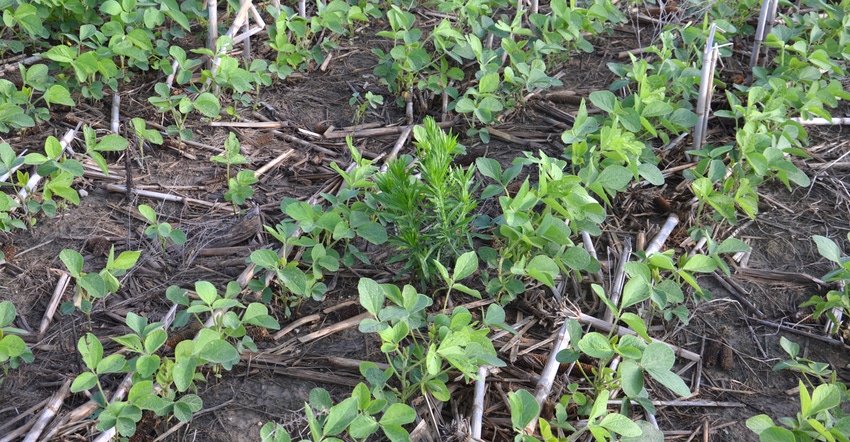July 13, 2022

With barley and wheat harvest wrapping up, double-crop soybean plantings will soon begin.
Weeds are generally less of a problem in double-crop soybeans because of the delayed planting date. But even with fewer weeds, when they are present and it is dry, the effects on yield can be noticeable.
A weed-free start is critical in double-crop soybeans, and one of the biggest concerns is managing glyphosate-resistant marestail, or horseweed. Some of these populations may also be ALS-resistant. Marestail that are cut off during small grain harvest will recover, branch out and probably be even more difficult to control.
In full-season soybeans, we have been advocating the use of 2,4-D LVE in the burndown program. However, most growers are not willing to wait the necessary seven days after 2,4-D application in double-crop systems, and there is potential for drift at this time of year. So, what are your options? Here are some ideas:
• For glyphosate-susceptible marestail, apply glyphosate at 1.5 pounds acid equivalent per acre (44 fluid ounces of Roundup PowerMax), or 64 fluid ounces of a 3-pound acid equivalent gallon per acre.
• Include 1 pint per acre of 2,4-D LVE in the burndown, and wait seven days to plant. If planting an Enlist E3, Enlist One/Duo could be applied, and then soybeans planted immediately. But be cautious of drift to sensitive areas.
• Add 1 ounce of Sharpen (or equivalent rates of Zidua Pro, Optill, or Verdict) to glyphosate to control marestail stumps. Keep in mind that Sharpen at this rate helps with burndown, but it does not provide much residual control. Adding metribuzin improves residual control.
• Add FirstRate (or Authority First or Sonic) or a chlorimuron-containing product (Authority XL, Canopy, Envive, Synchrony, Valor XLT) to improve control if the population is not ALS-resistant. Also, root uptake of Valor XLT/Envive may help kill marestail stumps. Keep in mind that if you tank-mix other PPO (group 14) products that contain Valor or Authority with Sharpen, there is a 14-day wait period before planting. Valor and Authority-containing products provide residual control of emerging Palmer amaranth and waterhemp seedlings.
• Use Liberty or other generic versions at 32 to 43 fluid ounces in the burndown application. This is good on marestail, but not as effective on some other weeds such as large annual grasses or Canada thistle. You can tank-mix with other herbicides to improve performance and provide some residual control. Glyphosate (32 fluid ounces) can also be tank-mixed with Liberty to improve the spectrum of burndown control.
• Gramoxone is a burndown option, too, and has some activity on marestail if they are less than 3 inches tall, but good coverage is essential.
• Dicamba is not recommended as a burndown in double-crop soybeans since it can be risky. At this time of year, many sensitive crops and ornamentals are susceptible to dicamba, and weather conditions favor dicamba drift. Furthermore, since the June 30 deadline is already upon us, Engenia, Xtendimax and Tavium cannot be legally applied.
Planting and non-GMO options
• Plant a LibertyLink, LLGT27 or Enlist E3 soybean variety, and apply Liberty, or other labeled glufosinate product, postemergence as needed.
• Plant a Roundup Ready soybean and apply glyphosate postemergence if marestail or Palmer amaranth are not problems.
• If you’re interested in non-GMO soybeans, a number of postemergent herbicides are still available, but many of the broadleaf products have some potential for soybean injury and are not effective for marestail control.
• Residual herbicides can be a critical component for weed control in double-crop beans, especially if Palmer and waterhemp are problems in your fields. However, for residuals to be effective, they need to be activated by at least 0.5 inches of rainfall within seven to 10 days of application and before weed seed germination. Medium- and high-solubility products such as s-metolachlor, acetochlor, metribuzin, Outlook, Pursuit, Reflex and Spartan/Authority tend to perform somewhat better in the summer since rainfall can sometimes be limited for proper activation.
Lingenfelter is an Extension weed science associate with Penn State Cooperative Extension
Source: Penn State Cooperative Extension, which is solely responsible for the information provided and is wholly owned by the source. Informa Business Media and all its subsidiaries are not responsible for any of the content contained in this information asset.
You May Also Like




